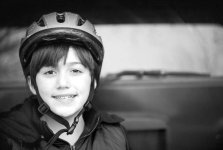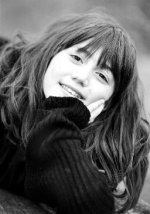One must first distinguish between formal and informal portraits.
Formal portraits are done with a tripod, and ideally, a remote shutter release. A camera that allows actual framing is useful. SLRs work well, as do larger format cameras with removable backs and ground glass for direct focus.
The aperture to use is of course up to the photographer. Typically, one tries only to keep the face in focus, with the area of sharpest focus being on the eyes or leading eye if the subject is sitting at an angle to the camera.
Aperture controls two things in these circumstances, depth-of-field and lens softness. Using aperture to control exposure is less of an issue in studio settings, where light and shutter speed are more-or-less in your control, so you can use the aperture you wish without regard to exposure (within the limits of the equipment you have).
DOF is controlled by the f-stop you select and the distance to the subject. You get less DOF (as mentioned by others in this thread) if you get closer to the subject. So you can decrease DOF as you like by either getting closer, or opening up the f-stop of your lens. Distance, of course, is also limited by the focal length of your lens.
As to softness, many top-notch lenses are nearly as good wide-open as they are stopped down, but overall, many portraitists prefer some softness. This accounts for the continuing popularity of older lenses, even uncoated or obsolete formula lenses in an effort to obtain a 'look' to a portrait that is more than just period costume and older lighting techniques.
No one can say what the 'best' aperture for portraits is, since that is down to personal taste, abilities, customer request, and so on. Wide open lenses are often preferred for portraits, because it de-emphasizes the background and places attention on the subject. Too much sharpness can bring unwanted attention to facial, er, problems shall we say, so that's another stroke for the open lens.
Now, as to informal portraits - or environmental portraits, or event photography where you try to get a photo of a face - there are different constraints.
A wider aperture is often preferred here too - also to isolate the subject from the background. However, a shallow depth-of-field can result in out-of-focus subjects, and that's not good either. I would also say that a rangefinder camera, as capable as it is, is not the best choice for these types of portraits either, if the subject is moving while you try to take photos. If they're willing to sit for you, then perhaps.
I'd like to refer you to some shots I took this weekend. There are some good and some not so good shots in there. However, I'd like to draw your attention to something that may help illustrate:
http://www.flickr.com/photos/wigwam/sets/72157600377187355/
To begin, I used the 'auto' setting on my digital SLR. This resulted in two problems. One was overexposure, which I soon caught and fixed, but more importantly, since I was not trying to control my aperture, and it was a bright day, the camera selected apertures like f/8. With my long lens (70~210, which is multiplied by 1.5 on my DSLR), f/8 is not all that deep, but it was deep enough to create nicely focussed backgrounds as well as foregrounds. Very distracting. You can click on the photos below if you want to see them bigger.
See?

Now, later on I twigged to my mistake - yes, I make a lot of mistakes. I set my camera to Manual, metered the scene and and choose the fastest aperture I had on that lens - f/3.5 ~ f/5.6, with a matching shutter speed. Here's another example:

Notice the background. Nicely blown away into fuzziness. This is a function of the wider f-stop, and the dancer being closer to me physically. However, there is always a tradeoff. Notice that I did not get the focus totally dead-on. The subject's eyes are not the area of prime focus, and his leading hand is out of focus, since the DOF for this shot was probably about 1 foot or less. However, I consider it 'better' than the previous shot, less distracting from the main subject, and I like it.
Feel free to critique my ability at controlling my DOF - I know some of these shots are not great. But they work as exemplars of what did work and what worked kinda ok, and what worked well. This is my favorite shot of the set:

Notice on this one, the dancer was very close to me, I used the long end of my lens, and I had it as open as it would go for this focal length (f/5.6), so the background was very blown out. There are some slight distractions I could probably photoshop out, but this is a jpg photo, right out of the camera, no manipulation at all (they all are). If I were going to print this one, I'd ajust levels and clean it up some, but it is basically good to go as-is.
That's DOF control. How you like it is up to you, but that's how you do it.
Feel free to knock me around a bit - I'm cool with that.









